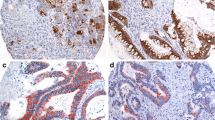Abstract
Background
Mucinous gastrointestinal cancers may indicate a higher propensity for widespread peritoneal seeding than their non-mucinous counterparts. We hypothesized that mucin content of gastrointestinal cancer cells and tumors is an indicator of cell viability and a determinant of the peritoneal tumor burden and tested our hypothesis in relevant experimental models.
Methods
MKN45 and LS174T models of human gastrointestinal cancer were treated with known mucin-depleting agents in vitro and in vivo, their mucin production was evaluated with Western blot immunohistochemistry, PAS staining and ELISA, and its correlation with cell viability and peritoneal tumor burden was analyzed.
Results
A relationship was found between the viability of cancer cells and their mucin levels in vitro. In agreement, when treated animal models were categorized into low- and high-burden groups (based on the weight and number of the peritoneal nodules), tumoral mucin levels were found to be significantly higher in the latter group.
Conclusions
Tumoral mucin is apparently among the factors that dictate the pattern and extent of the peritoneal spread of gastrointestinal cancer, where it allows for enhanced dissemination and redistribution. If further tested and validated, our hypothesis could lay the basis for the development of novel mucin-targeted strategies.


Similar content being viewed by others
References
Sugarbaker PH. Peritoneum as the first-line of defense in carcinomatosis. J Surg Oncol. 2007;95:93–6.
Sugarbaker PH. Management of peritoneal-surface malignancy: the surgeon’s role. Langenbecks Arch Surg. 1999;384:576–87.
Esquivel J. Treatment of peritoneal surface malignancies. Surg Oncol Clin N Am. 2012;21:xv–xviii.
Mohamed F, Cecil T, Moran B, Sugarbaker P. A new standard of care for the management of peritoneal surface malignancy. Curr Oncol. 2011;18:e84–96.
Carmignani CP, Sugarbaker TA, Bromley CM, Sugarbaker PH. Intraperitoneal cancer dissemination: mechanisms of the patterns of spread. Cancer Metastasis Rev. 2003;22:465–72.
Hollingsworth MA, Swanson BJ. Mucins in cancer: protection and control of the cell surface. Nat Rev Cancer. 2004;4:45–60.
Jonckheere N, Skrypek N, Van Seuningen I. Mucins and tumor resistance to chemotherapeutic drugs. Biochim Biophys Acta. 2014;1846:142–51.
Nath S, Mukherjee P. MUC1: a multifaceted oncoprotein with a key role in cancer progression. Trends Mol Med. 2014;20:332–42.
Singh A, Settleman J. EMT, cancer stem cells and drug resistance: an emerging axis of evil in the war on cancer. Oncogene. 2010;29:4741–51.
Amini A, Masoumi-Moghaddam S, Ehteda A, Morris D. Bromelain and N-acetylcysteine inhibit proliferation and survival of gastrointestinal cancer cells in vitro: significance of combination therapy. J Exp Cli Cancer Res. 2014;33:92.
Amini A, Masoumi-Moghaddam S, Ehteda A, Liauw W, Morris DL. Depletion of mucin in mucin-producing human gastrointestinal carcinoma: results from in vitro and in vivo studies with bromelain and N-acetylcysteine. Oncotarget. 2015;6:33329–44.
Amini A, Masoumi-Moghaddam S and Morris DL. Utility of bromelain and N-acetylcysteine in treatment of peritoneal dissemination of gastrointestinal mucin-producing malignancies. Springer International Publishing; 2016.
Gum JR Jr. Mucin genes and the proteins they encode: structure, diversity, and regulation. Am J Respir Cell Mol Biol. 1992;7:557–64.
Amini A, Masoumi-Moghaddam S and Morris DL, editors. Mucins and tumor biology. In: Utility of bromelain and N-acetylcysteine in treatment of peritoneal dissemination of gastrointestinal mucin-producing malignancies. Springer International Publishing; 2016. p. 43–57.
Byrd JC, Bresalier RS. Mucins and mucin binding proteins in colorectal cancer. Cancer Metastasis Rev. 2004;23:77–99.
Sugarbaker PH. Pseudomyxoma peritonei. Cancer Treat Res. 1996;81:105–19.
Author information
Authors and Affiliations
Corresponding author
Ethics declarations
Conflict of interest
The authors declare that they have no conflict of interest.
Ethical approval
All applicable international, national, and/or institutional guidelines for the care and use of animals were followed. All procedures performed in studies involving animals were in accordance with the ethical standards of the institution or practice at which the studies were conducted.
Rights and permissions
About this article
Cite this article
Masoumi-Moghaddam, S., Amini, A. & Morris, D.L. Is mucin a determinant of peritoneal dissemination of gastrointestinal cancer? Analysis of mucin depletion in two preclinical models. Clin Transl Oncol 19, 261–264 (2017). https://doi.org/10.1007/s12094-016-1519-8
Received:
Accepted:
Published:
Issue Date:
DOI: https://doi.org/10.1007/s12094-016-1519-8




